JHP Newsletter - 2016, No. 4, 18 October
Greetings from Navajo Lake State Park, New Mexico.
Travel: South Africa
My time in South Africa was fantastic and quite different than what I usually experience there. I was there from mid August to early October, which is much earlier in their winter than I've been there since my first visit. That meant the temperatures in Kgalagadi Transfrontier Park, where I spent my first week, were surprisingly cold. The temperatures got down to 23-42°F (-5-5°C) at night but still got up to 65-90°F (18-32°C) during the day. They had been suffering from a drought and a lot of the vegetation had been nibbled down to practically nothing.
My first morning in Kgalagadi Transfrontier Park, which encompasses the former Kalahari Gemsbok National Park, started off with a bang (no pun intended) when I photographed a pair of lions mating close to the road. I thought that would portend good things to come, but instead it indicated that I was going to get screwed in the cat department for most of the rest of my visit. After those lions, I didn't photograph another cat, or even see a cheetah or leopard, until my last morning in the park.
Some of my favorite images are ones that are quite unlike previous images I've made such as this backlit Southern Yellow-Billed Hornbill (Tockus leucomelas) flipping a seed in its bill (below left). Another is this female Bateleur (Terathopius ecaudatus) eagle landing near a waterhole (below right). I've photographed them several times in flight from below, but never from near eye level. While she was still drinking, a male landed in a nearby perch and put on a very impressive display. It was the first time I had seen that behavior, but I couldn't photograph it because he was side lit and had his back to the sun. The female didn't seem impressed.
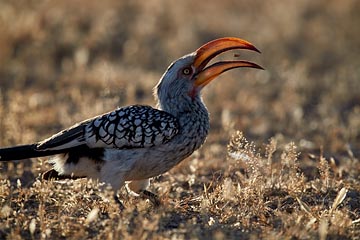
1/750 sec, f8, ISO 400
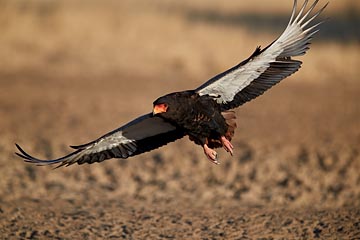
1/3000 sec, f5.6, ISO 640
Giraffe are quite skittish when they drink because they are vulnerable as they squat to reach the water. This Cape Giraffe (Giraffa camelopardalis giraffe) is raising his head in a hurry and slinging water out of his mouth (below left).

1/2000 sec, f4, ISO 125
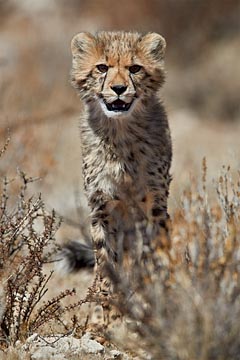
1/1000 sec, f8, ISO 400
On my last morning as I was leaving the park, I spotted a Cheetah (Acinonyx jubatus) mother with four young cubs walking up the dry Auob River towards two springbok. What a way to end my visit. I spent almost two and a half hours with them as they slowly made their way towards the springbok and lunch. The cubs generally did a good job staying behind their mother so she could stalk the prey, but they must have gotten restless because they moved up to her just when I thought she was about to make her move. The springbok decided that they had had enough of the cheetah's shenanigans and called out to let them know that they were not to be eaten right then. As all of this was happening, two gemsbok had come down over the riverbank behind the cheetahs, and when the cheetahs turned around after giving up on the Springbok, the gemsbok started chasing the cheetahs. It's a tough life being a cheetah! The mother and three of the cubs went up over the riverbank and out of sight, but one cub had stayed down low on the riverbank hiding behind a rock. After the gemsbok left, the remaining cub started calling for the rest of its family. After a while, the mother came over the riverbank and joined the cub that was in the shade of a tree. When the other cubs didn't arrive, even with the mother calling, I thought that she had lost them. After a while, she took the cub with her up over the riverbank and out of sight. I moved down the road along the dry riverbed in the direction that the cheetahs had been heading originally and then took a cross road to the top of the riverbank. I was relieved to see the cheetah mother with her four cubs, and I was excited to seem them approaching. I waited and they practically came right up to me. Even though it was literally high noon, it's not every day that you get to photograph a young cheetah cub from near eye level (above right)!
I spent a few days in Namaqualand, a region renowned for its wildflower bloom in August and September. I've been in the area before in mid to late September and missed the peak bloom, but I hit it right this time. The flowers were amazing! A typical scene is an entire area colored orange from the Namaqualand Daisy or Jakkalsblom (Dimorphotheca sinuate, below left). My favorite image is of a more intimate scene (below right).
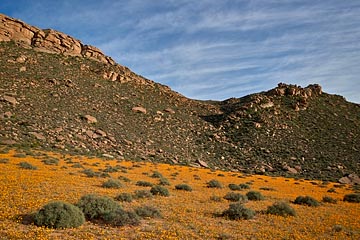
1/45 sec, f16, ISO 100
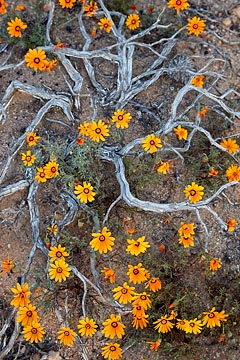
1/20 sec, f9.5, ISO 200
After spending two nights in Springbok, I spent three nights in Namaqua National Park at Skilpad, right in the heart of a dense wildflower area. On my first evening, I was thrilled to find this Springbok (Antidorcas marsupialis) buck among orange Namaqualand Daisies and Glossy-Eyed Mountain Daisies (below left). On my last morning, it was calm enough to do some macro photography, and this Glansooggousblom or Glossy-Eyed Mountain Daisy (Ursinia cakilefolia) was closed and covered with dew (below right). Most of the wildflowers close when the sun goes down and they only open after a few hours of sunlight.
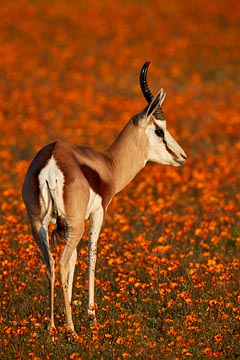
1/1500 sec, f8, ISO 1250
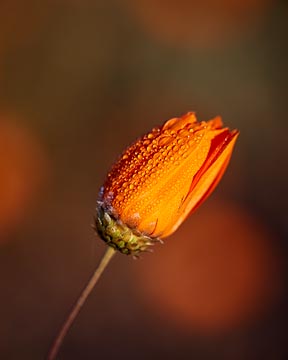
1/500 sec, f4.5, ISO 200
Near the beginning of September I spent three nights along the west cast. I started with two nights in Lamberts Bay where the main draw is Bird Island and the Cape Gannet (Morus capensis) colony. Photography is good there in the morning and I got this nice image of one landing (below left). In the afternoon and evening, I like to photograph at nearby Elands Bay. The wildflowers were good there too, but my favorite image from there is of the surf at sunset (below right).
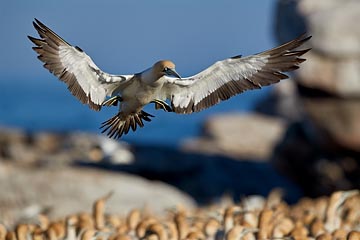
1/1500 sec, f6.7, ISO 250

1/4 sec, f13, ISO 100
I had planned to spend three nights in Lamberts Bay, but even four months in advance, I couldn't find reasonable accommodation there for the third night, so I looked for something further south. I settled on Langebaan because it's another hot spot for wildflowers. I visited West Coast National Park and enjoyed the wildflowers in the Postberg area of the park. In this image (below left), the orange African Daisy or Gousblom (Arctotis hirsuta) is surrounded by the White African Daisy, Cape Rain-Daisy, or Witbotterblom (Dimorphotheca pluvialis), and Blue Daisy or Bloumagriet (Felicia amelloides).

1/2000 sec, f5.6, ISO 200
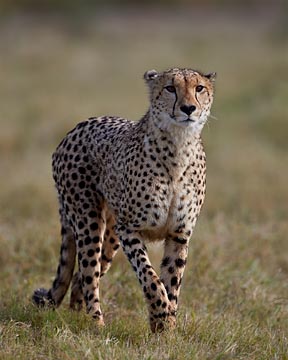
1/500 sec, f5.6, ISO 320
I spent three nights in Mountain Zebra National Park in early September and it was extremely dry. The vegetation was sparse and it was dusty. The wildlife was mostly busy grazing, and animals with their heads down aren't very interesting to photograph. I did, however, see lions in the park for the first time. Lions were reintroduced in April 2013 and I didn't see them on my visit in March 2015.
Then I spent three nights in Addo Elephant National Park in mid September, and shooting was slow there too. It didn't help that it rained almost all day on my first full day there. On my second full day, I saw Cheetah (Acinonyx jubatus) for the first time in the park, and it was three brothers (?) right by the road! I was able to get a nice image of one as he crossed a low-grass area (above left).
I ended my stay in South Africa with 2.5 weeks in Kruger National Park, and it was a very productive time! It was especially good for cats, and I had three good Leopard (Panthera pardus) encounters. The first was a female (I think.) feeding on a Cape Porcupine or South African Porcupine (Hystrix africaeaustralis) carcass. It must have been her first experience with a porcupine because she had a quill stuck in her mouth, one in her cheek, one in her neck, and several in her legs and belly. In this image (below left), she had finished eating and had tried to remove some of the quills.
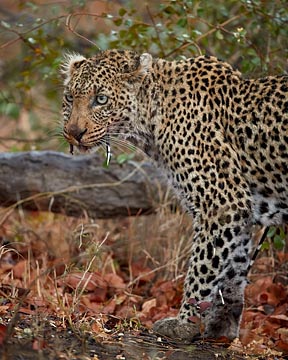
1/125 sec, f4, ISO 1600

1/1000 sec, f5.6, ISO 400
The second leopard was this very laid back male resting on the shoulder of the road (above right), and the solid overcast provided some great light to photograph him. I learned from another vehicle that there was a female in the area and that they were mating. When the big guy finally got up, he headed towards the female through a fairly open area that would have been good for photography, but she didn't come join him. Instead, they went into some thick brush and out of sight and I only heard them mate. Still, that was the closest I've been to seeing leopards mate!
I had three different Cheetah (Acinonyx jubatus) sightings, and the best by far was a mother with five three- to four-week old cubs. They were the smallest cubs I've seen or photographed, so it was quite a thrill to spend some time with them. Early in my encounter, the five cubs posed fairly nicely, but behind some distracting brush (below left). Near the end of my encounter, the mother was leading the cubs roughly parallel to the road, but still behind lots of inconvenient brush (below right).
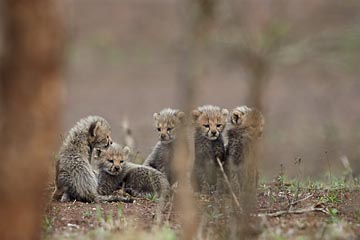
1/350 sec, f8, ISO 1600
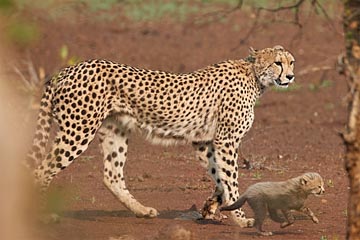
1/1500 sec, f8, ISO 1000
I had more Lion (Panthera leo) encounters on this visit to Kruger than I've ever had before. It's always exciting to see and photograph a pair of lions mating, but it was also frustrating to photograph this pair (below left). They were nice and close to the road, but they only copulated for 5-10 seconds and I couldn't get into position in time to photograph them the first few times because of the brush. I was finally able to get nice shot of them right before I had to leave to return to camp.

1/750 sec, f4, ISO 640
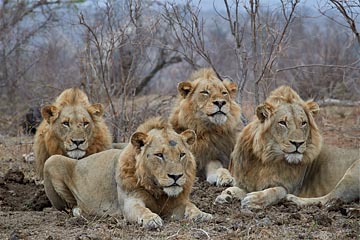
1/90 sec, f16, ISO 1000
One of the most unusual images I made is of this group of four male lions (above right) watching a small group of Cape Buffalo approach. I've never seen a group of four adult males before, and there was a fifth just across the road in the early stages of mating with a female. I was surprised to see these males resting atop a rhino midden pile, but I suppose it was cushy and probably warm on that cool morning from the decaying organic matter.
Another favorite lion image is this one (beow left) of a big male. I spotted him first thing in the morning and he was alert while watching the humans arrive in their shiny metal boxes. After a short time, he went back to the more typical cat activity of napping. Because he had eaten recently, he probably wouldn't do anything too exciting for a while, so I left to look for other interesting species that had been seen in the area: leopard and African wild dog. I didn't see them so I circled back to the lion. He had gotten up, crossed the road and the small, mostly-dry stream, and was walking slowly along the far bank. The vegetation on my side of the stream was fairly thick so it was hard to find good windows to shoot through. I eventually got ahead of him quite a bit to a large window and waited. He had dropped down to the stream level by the time I saw him again, and he very kindly walked up the game trail straight towards me. Even though he was below my eye level, I was looking almost along the extension of the game trail, so the perspective as he approached heading up the hill was spectacular!
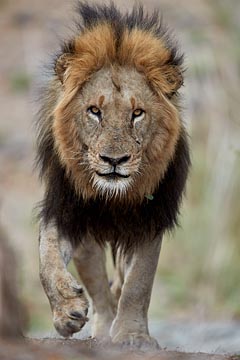
1/500 sec, f4, ISO 320
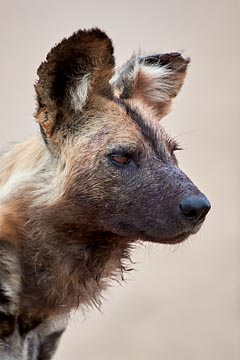
1/125 sec, f5.6, ISO 1600
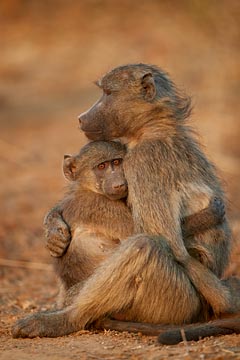
1/750 sec, f4, ISO 640
I only had one encounter with African Wild Dog, African Hunting Dog, or Cape Hunting Dog (Lycaon pictus), but it was with a pack of more than 20 including several young. This adult posed briefly for a portrait (above center). One of my favorite Chacma Baboon (Papio ursinus) images of the trip is this one (above right) of an adult female comforting a young one.
This Leopard Tortoise (Geochelone pardalis) was in a great location (below left). First, it was near the crest of a small hill so I could shoot from a beanbag on the ground to get a great below-eye-level perspective. Second, it was in area with no dangerous animals so I could safely get out of my vehicle and there were no other vehicles so I wouldn't be harassed by humans concerned about my safety.
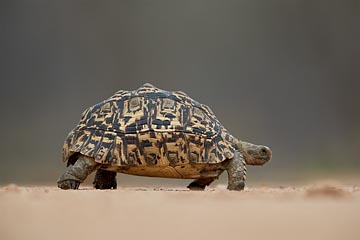
1/750 sec, f8, ISO 1250
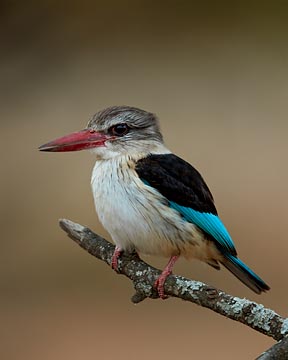
1/250 sec, f8, ISO 1250
I had a great time photographing this Brown-Hooded Kingfisher (Halcyon albiventris) that was extremely cooperative (above left). It moved from perch to perch looking for prey, and would occasionally pop down to the ground to catch something. As soon as it landed on this perch, I knew I had a winner!
Biyamity Dam is one of my favorite locations for photography in the park because the dam is low and there's a causeway immediately downstream so that the water level above the dam is less than a foot below a car's windowsill. I went by there on my way from one camp to another to check conditions to see if I should return first thing the next morning. I was excited to find this Hippopotamus (Hippopotamus amphibius) sparring with an intruder in his pool (below left).
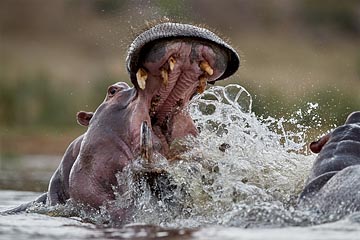
1/1500 sec, f5.6, ISO 800
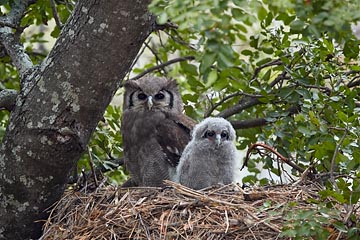
1/60 sec, f8, ISO 1600
The final image from Kruger is of a Verreaux's Eagle Owl or Giant Eagle Owl (Bubo lacteus) adult and chick on their nest (above right). I've photographed adults several times before, but never on the nest with a chick.
Travel: Colorado Fall Color
After a few days recovering from jet lag, which went away a lot faster than usual, I met up with Jan in the San Juan Mountains of southwestern Colorado to photograph the fall color in early October. The color peaked earlier this year than usual, and I missed it because I was in South Africa. I almost didn't go, but am glad I did because it's one of my favorite locations in the lower 48 and I was able to make images that are different than I've made before with the bare aspen (below left and right).
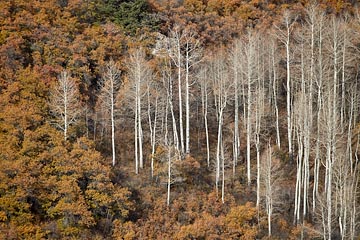
1/90 sec, f8, ISO 100
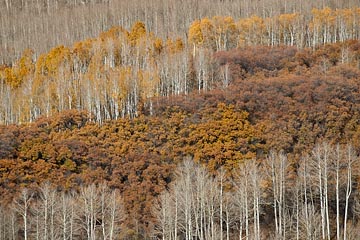
1/60 sec, f11, ISO 100
Conditions were also good for some grand-landscape images similar to what I've made before, but the aspen with a lot of their leaves gone created a different look. One of my favorite areas for sunset is Owl Creek Pass, and the clouds cooperated one evening (below left). I love to photograph the fall color in the San Juan Mountains because the Sneffels Range usually has snow on it which makes a fantastic background. Based on how the clouds were forming before sunrise one morning, I headed to an area to take advantage of them. As I was leaving, I could see that a fantastic cloud had formed above Wolcott Mountain, so I headed to an area to photograph it, and made it in time before the cloud disappeared.
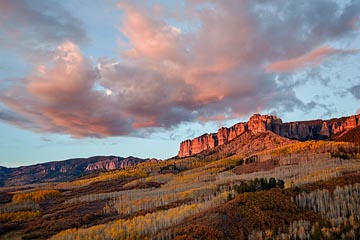
0.3, 1/6, and 1/10 sec; f11; ISO 100
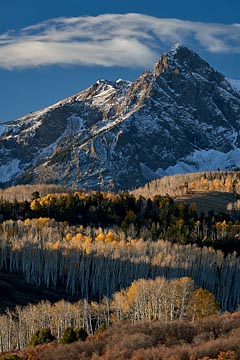
1/60 sec, f8, ISO 100
We've been enjoying our time at Navajo Lake State Park. I've been out kayaking every morning and I've gotten lots of office work done too.
Take care and happy shooting.
— James
James Hager Photography :: www.jameshagerphoto.com




